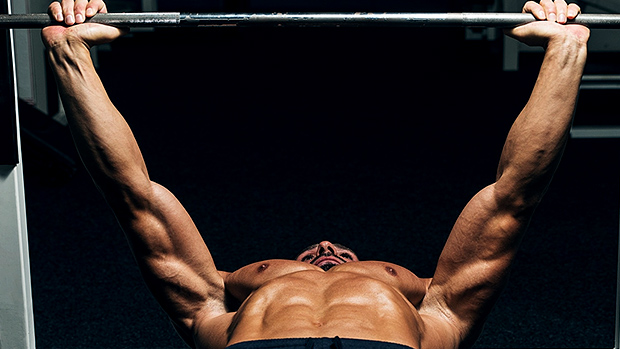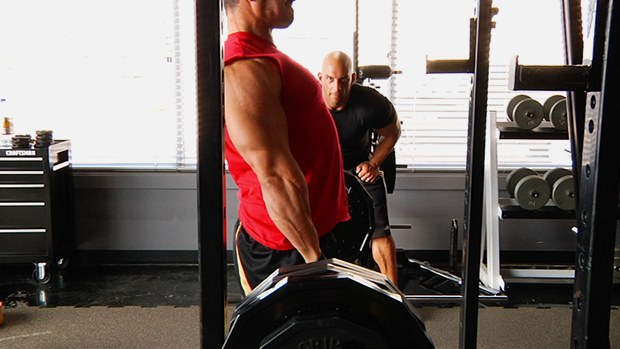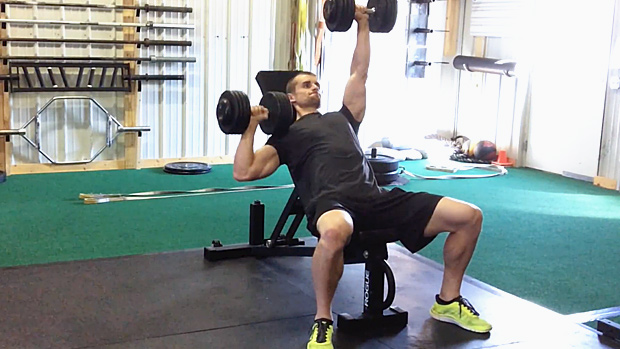Here's what you need to know...
- The Olympic deadlift is a hybrid of the deadlift and the traditional Olympic clean pull.
- What makes this exercise different from the traditional deadlift is that it involves a much greater range of motion. Think vertical jump, except your feet don't leave the floor.
- Since the Olympic deadlift and the conventional deadlift share some similarities, you can transition straight into deadlifts after finishing your Olympic deads without a warm up.
- Olympic deadlifts will build huge calves, traps, and hamstrings without working on them directly in separate exercises. They'll also improve your conditioning.
The "Olympic deadlift" is an exercise I created that's a hybrid between deadlifts and the traditional Olympic clean pull. The grip width and the starting position is the same as it is for a regular deadlift with the bar above your toes and your shoulders over the bar, but your finishing position is like the end of a clean pull where you end up on your toes and your shoulders almost touch your ears. There's also a pause at the end of the movement to put more emphasis on the calves and traps.
This movement has several benefits:
- Starting your regular deadlift session with an explosive movement is the best way to activate your CNS in order to maximize the potential of a deadlift workout to follow.
- Deadlifts will still be the foundation of your workout, but starting with Olympic deadlifts will make your standard deads feel lighter and you'll be more explosive from the floor.
- Olympic deadlifts are a great way to build bodybuilder calves, traps, and hamstrings without working on them directly in separate exercises. As a bonus, they're great for conditioning.
- Olympic deadlifts improve overall coordination, explosiveness, power, and speed.
- The stronger you get at Olympic deadlifts, the stronger your conventional deadlift will become. Think about it: you're moving from a very large range of movement to a smaller one, and from a pure explosive movement to a pure strength movement.
If You're Still Not Convinced...
I've never done shrugs or calf exercises but surprisingly, calves and traps are two of my best body parts. Why? Because I was an Olympic weightlifter before I started bodybuilding. Doing exercises like clean pulls or snatch pulls involved those muscles in a different way than traditional exercises. My Olympic deadlifts work the same way. Give them a shot and you'll notice that your calves and traps will grow really fast, in addition to making you stronger and giving you a larger back.
What makes this exercise different from the traditional deadlift is that it involves a much greater range of motion. You'll finish on your toes with your "shoulders touching your ears" and all of your joints locked and the body straight. It's almost like a vertical jump, except your feet don't actually leave the floor. Since they're so explosive, 3-4 sets of 6-8 reps of Olympic deadlifts will leave you huffing and puffing as if you'd just finished a grueling HIIT cardio session.
That's no surprise, because the speed and explosiveness this exercise requires will force you to activate almost every muscle group in your body from head to toe, in addition to your CNS. As a result, nothing prepares you better for a subsequent heavy deadlift session.
Since the Olympic deadlift and the conventional deadlift share some similarities, you can transition straight into deadlifts after finishing your Olympic deads without any warm up or "feeder sets." For example, if you finish your Olympic deadlifts with 315 pounds, you can start your deadlifts at 365. The Oly deads won't take any extra energy from your workout; they're just a natural progression into your deadlift.
Putting Them Into Practice
Leave your ego at the door and warm up with a wooden stick to get a feel for the movement. Then continue with the Olympic bar. Do 4 sets of 6-8 reps, increasing the weight every set. When you get to a point where your speed and explosiveness are compromised by the weight, it's time to transition into your deadlifts.





